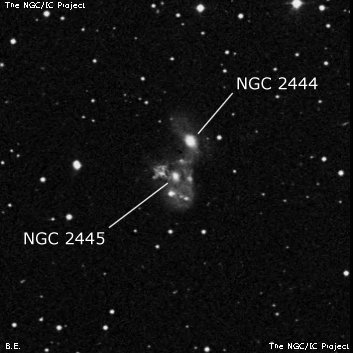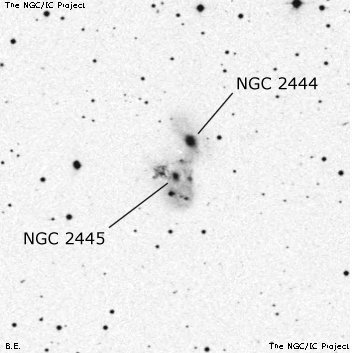NGC/IC Project Restoration Effort
(This is a very very beta version)
NGC2445


Basic Information
Location and Magnitude
Right Ascension: 7:46:55.0
Declination: +39:0:56
Constellation: LYN
Visual Magnitude: 13.3
Historic Information
Discoverer: Stephan
Year of discovery: 1877
Discovery aperture: 31.0
Observational
Summary description: vF, mbM, S * att s
Sub-type: Ring B
Steve's Notes
=====
NGC 2445
48" (4/5/13): this remarkable ring galaxy forms an interacting pair with NGC 2444, just 1' N. At 488x, it was resolved into six components -- the bright ring nucleus and five very small HII regions which are roughly equally spaced around the nucleus (separations between 25" and 42"). The four closest (VV 117b, 117e, 117f, 117g) form a very small square with the nucleus at the center! The nucleus appears moderately bright to fairly bright, small, round, high surface brightness, 15" diameter. The five HII regions are within an irregular, triangular glow, ~1.5' diameter.
VV 117b is at the northern end of NGC 2445, just 27" N of the nucleus and 36" SSE of NGC 2444. It appeared very faint, very small, round, 8" diameter. VV 117f is situated 25" W of the nucleus and appeared very faint to faint, very small, round, 10" diameter. VV 117h is at the SW corner (42" SW of the nucleus) and was the faintest of the 5 knots surrounding the nucleus. It appeared extremely faint and small, round, just 5" diameter. VV 117e is at the east end (35" E of the nucleus) and appeared very faint to faint, very small, irregularly round, ~12" diameter.
Finally, VV 117g is at the southeast corner, 30" S of the nucleus, and appeared fairly faint, very small, round, high surface brightness, 12" diameter. This object was the brightest of 5 "knots" surrounding the nucleus, although on the SDSS it appears to be an HII region attached to a foreground star, which certainly contributed to its brightness. In the 2009 Madore "Atlas and Catalogue of Collisional Ring Galaxies" VV 117g is identified as the second collider (C2).
13.1" (1/18/85): this is the SE component of a double galaxy with NGC 2444. Both appear as two nearly stellar knots oriented NNW (NGC 2444) and SSE (NGC 2445) with a separation of 1.0', surrounded by faint halo which may merge.



